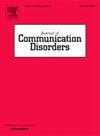中耳炎对儿童语言产生的影响:一项系统综述。
IF 2.1
3区 医学
Q2 AUDIOLOGY & SPEECH-LANGUAGE PATHOLOGY
引用次数: 0
摘要
中耳炎(OM)是幼儿最常见的感染之一,可造成波动性听力损失。尽管这种情况具有普遍性,但缺乏关于其对言语产生结果的影响的确凿证据。因此,本系统综述的目的是确定中耳炎对儿童语言产生的影响。方法:采用5个数据库(PsycINFO、Medline、CINAHL、Pubmed和SpeechBITE)对2000年以来同行评议的出版物进行系统综述。如果研究报告以前或现在有中耳炎(OM)的经历,评估和报告12岁前儿童的语言产生,并评估儿童的英语语言产生,则将其纳入研究。回顾了332篇文章的标题和摘要,随后回顾了58篇研究的全文。由于研究过程和结果的可变性,完成了叙事综合。结果:12项研究符合本综述的纳入标准,调查了1265名12个月至7岁的儿童。8项研究采用前瞻性设计,3项研究采用回顾性设计,1项研究采用案例研究设计。六项研究没有发现OM和语言产生之间的关系,尽管其中五项研究是对639名儿童进行的更大研究的一部分。相比之下,五项研究确定了OM病史、OM的慢性性和/或听力水平升高和语言产生之间的联系。具体来说,OM与阻碍中支持的存在有关。结论:由于存在多种影响变量,如持续时间、严重程度、医疗干预、年龄、听力状况和社会经济状况,总体结果可能是混合的。本综述的结果是有限的,因为前瞻性研究只考虑了治疗的OM病例,因此不代表患有不明和/或未经治疗的OM的儿童。此外,许多研究没有一致地报告儿童的听力水平,只有两项研究纳入了土著背景的儿童群体。本文章由计算机程序翻译,如有差异,请以英文原文为准。
The impact of otitis media on speech production in children: A systematic review
Introduction
Otitis Media (OM) is one of the most common infections in young children and can create fluctuating hearing loss. Despite the commonality of this condition, there is a lack of conclusive evidence on its impact on speech production outcomes. Therefore, the aim of this systematic review was to identify the impact of otitis media on speech production in children.
Method
A systematic review of peer-reviewed publications since 2000 was conducted using five data bases (PsycINFO, Medline, CINAHL, Pubmed and SpeechBITE). Studies were included if they reported a previous or current experience of otitis media (OM), assessed and reported on the speech production of children before the age of 12 years and the child's speech productions were assessed in the English language. Titles and abstracts of 332 articles were reviewed, followed by full-text review of 58 studies. Due to variability in study procedures and outcomes, a narrative synthesis was completed.
Results
12 studies met inclusion criteria for this review investigating 1,265 children aged between 12 months and 7 years of age. Eight studies used a prospective design, three studies used a retrospective design, and one study used a case study design. Six studies found no relationship between OM and speech production although five of these studies formed part of a larger study of 639 children. Comparatively five studies identified a link between OM history, chronicity of OM and/or elevated hearing levels and speech production. Specifically, OM was linked to the presence of backing in obstruents.
Conclusions
Overall findings were mixed likely due to the presence of multiple influencing variables such as duration, severity, medical intervention, age, hearing status and socio-economic status. Results of this review are limited as prospective studies only considered cases of OM which are treated and therefore do not represent children who have unidentified and/or untreated OM. Furthermore, many studies did not consistently report on the hearing levels of children and only two studies included cohorts of children from an Indigenous background.
求助全文
通过发布文献求助,成功后即可免费获取论文全文。
去求助
来源期刊

Journal of Communication Disorders
AUDIOLOGY & SPEECH-LANGUAGE PATHOLOGY-REHABILITATION
CiteScore
3.30
自引率
5.90%
发文量
71
审稿时长
>12 weeks
期刊介绍:
The Journal of Communication Disorders publishes original articles on topics related to disorders of speech, language and hearing. Authors are encouraged to submit reports of experimental or descriptive investigations (research articles), review articles, tutorials or discussion papers, or letters to the editor ("short communications"). Please note that we do not accept case studies unless they conform to the principles of single-subject experimental design. Special issues are published periodically on timely and clinically relevant topics.
 求助内容:
求助内容: 应助结果提醒方式:
应助结果提醒方式:


